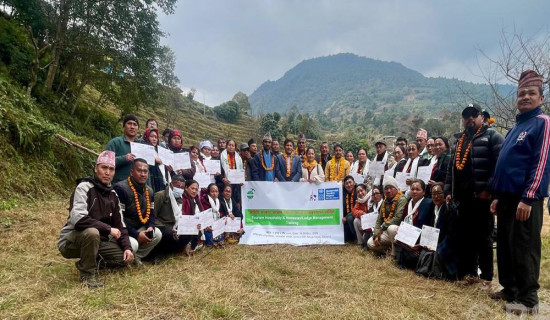- Sunday, 21 December 2025
Concentrate On Proper Tourism Planning
Nepal is an awesome country in her natural and cultural attributes. As new governments are at the stage of taking off for the desired level of development, it is their major responsibility to develop the nation with limited recourses. It is not impossible through an integrated development approach, that is, tourism planning and development.
Most probably one and a half million tourists may visit in Nepal this year. The numbers could be doubled in 2024, if governments move in tourist friendly mode. Leaders normally talk about Singapore, or Switzerland while talking about Nepal’s development. Covering an area of 728.6 square kilometres, Singapore is home to 5.7 million people. In 2019, the country hosted 19.12 million tourists. The figure is four times higher than the country’s population. The Kathmandu Valley spreads over 665 square kilometres and the number of its population stands at about 1.45 million. Only Kathmandu can carry 70 million tourists if the administration manages through tourism planning.
Basic responsibility
D. Getz (1987) defines tourism planning as” a process, based on research and evaluation, which seeks to optimise the potential contribution of tourism to human welfare and environmental quality.” Tourism planning is research for social well-being and this is the basic responsibility of governments. Similarly, according to Faludi (1973), “Planning is a very important part of the process by which tourism is managed by governments at the national, local and organisational levels”. Thus tourism planning guides governments for better governance.
Tourism planning is the idea or process to integrate social, cultural, economic and environmental values of a specified location to develop its: accessibility (modes of transportation- airports, roadways, waterways), accommodation (modes of night stay- campsite, Homestay, hotel, lodge, motel, resort, temple stay, etc.), action (annual budgets and programmes of governments for tourism development of the location- awareness, conservation, construction, management, protection, training, etc.). Besides, activity includes what a tourist can do such as cannoning, climbing, dancing, drinking, eating, gambling, hiking, paragliding, trekking, watching, etc.). Likewise, marvelous standard facilities (antique atmosphere, cultural services, herbal massage, royal foods, Vedic yoga, etc.) fall under amenity. Ancillary embodies secondary services such as banking, credit, drop, insurance, ticketing and so on while attraction includes culture, history, hospitality, monuments, nature, souvenir, temples, etc.
Tourism development of any nation or destination is possible with planning and management of these 7As. In reality, tourism development leads to the development of society, economy and the conservation of ecology and culture. Thus, tourism development is an integrated development. If a government is eager to develop its territory, it must initiate tourism planning immediately.
In general, planning is a roadmap of where are we and where we want to go. India and China are the biggest tourist source markets for Nepal. In 2019, Nepal welcomed as many as 210,000 Indian tourists and about 108,000 Chinese ones. China and India are the most populous emerging economies in the world. Thus, in the next few years, if good governance is secured, Nepal will be a must-visiting holiday destination for middle-class Chinese and Indians. These two nations have been achieving good economic growth over the years. When they are able to give continuity to the current trend of economic growth, there will be one under the poverty line by 2030. It means 80 per cent population will be economically ready to visit. People spend income in close safety and wonderful destination. So, this is the right time for Nepali tourism planners to work towards capturing Chinese and Indian market potentialities.
The number of outbound tourists in China in 2018/19 was 155 million while it was at 27 million in India. Nepal had set a target of welcoming 2 million international tourists by 2020 as the nation had announced the Visit Nepal-2020. Some of the scholars were claiming it was a very ambitious plan. The target was not ambitious as such. However, the nation had limited infrastructures. Now Nepal has to be prepared to welcome a host of tourists from China and India. Governments at every level need absolute tourism planning. This type of planning bridges the gap between where we are and where we want to go.
No budget syndrome
The biggest problem of the Nepali academia and bureaucracy is no budget syndrome. Budget is a manageable phenomenon. If there is a will, there is a way. There are thousands of ways to manage local, natural, cultural, national, and international sources. Budgeting is simply an absolute resource planning. To manage the inflow of 2 million tourists, Nepal had significantly developed its homestays. There are now formal plus informal around 1000 homestays, with 5000 rooms, with 10,000 beds successfully running all over Nepal. Most governments have prepared a land use policy that gives detailed zoning to the development activities.
Every Nepali must have at least a worship/meditation and guest room in their home. It is a culture of Nepal. So every household is Atithi Griha in Nepal- homestay. The nation has everything because of the philosophy of “Atithi devobhava” (guests are like god in Nepali). We will get the absolute opportunity to serve millions of Indians and Chinese tourists. Following the Dharma of Atithi – tourism, we will be blessed socially, economically, and spiritually. It is not the matter of budget but of motivation to the people to promote the Nepali hospitality.
(Dr. Badal is a practicing scholar of rural tourism development and planning. bpb222@yahoo.com)











-(1)-original-thumb.jpg)




